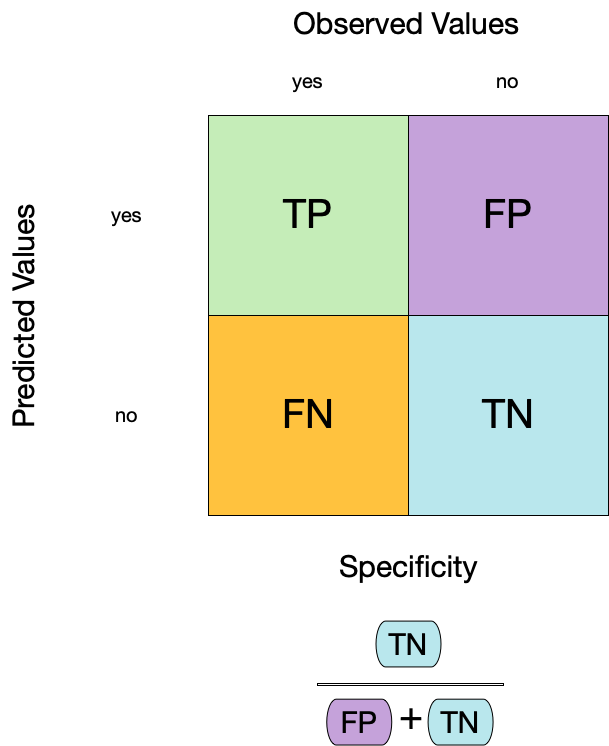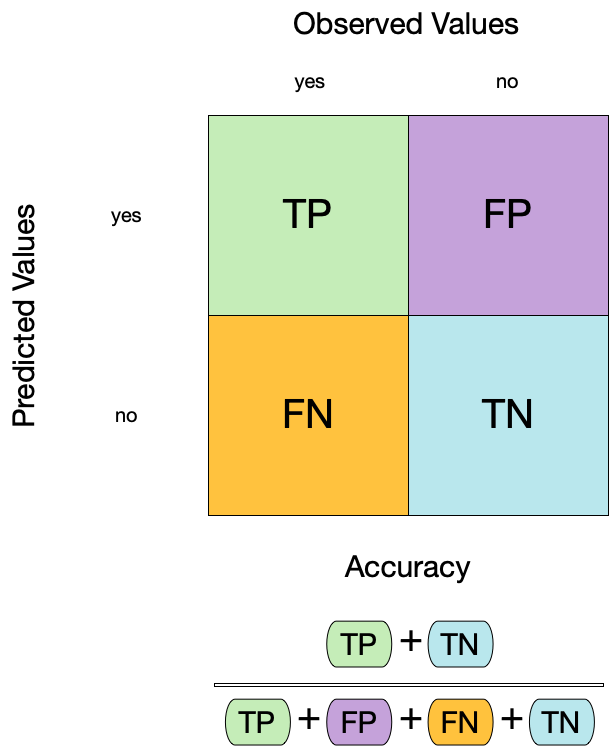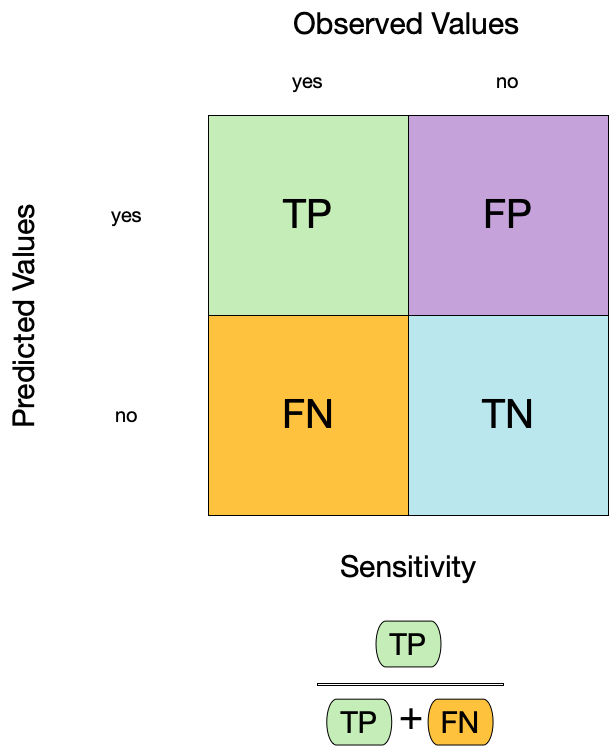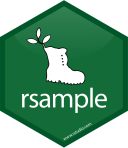augment(forested_fit, new_data = forested_train)
#> # A tibble: 5,685 × 22
#> .pred_class .pred_Yes .pred_No forested year elevation eastness northness
#> <fct> <dbl> <dbl> <fct> <dbl> <dbl> <dbl> <dbl>
#> 1 No 0.0114 0.989 No 2016 464 -5 -99
#> 2 Yes 0.636 0.364 Yes 2016 166 92 37
#> 3 No 0.0114 0.989 No 2016 644 -85 -52
#> 4 Yes 0.977 0.0226 Yes 2014 1285 4 99
#> 5 Yes 0.977 0.0226 Yes 2013 822 87 48
#> 6 Yes 0.808 0.192 Yes 2017 3 6 -99
#> 7 Yes 0.977 0.0226 Yes 2014 2041 -95 28
#> 8 Yes 0.977 0.0226 Yes 2015 1009 -8 99
#> 9 No 0.0114 0.989 No 2017 436 -98 19
#> 10 No 0.0114 0.989 No 2018 775 63 76
#> # ℹ 5,675 more rows
#> # ℹ 14 more variables: roughness <dbl>, tree_no_tree <fct>, dew_temp <dbl>,
#> # precip_annual <dbl>, temp_annual_mean <dbl>, temp_annual_min <dbl>,
#> # temp_annual_max <dbl>, temp_january_min <dbl>, vapor_min <dbl>,
#> # vapor_max <dbl>, canopy_cover <dbl>, lon <dbl>, lat <dbl>, land_type <fct>4 - Evaluating models
Introduction to tidymodels
Looking at predictions
Confusion matrix ![]()

Confusion matrix ![]()
Confusion matrix ![]()
Metrics for model performance ![]()
Metrics for model performance ![]()
Metrics for model performance ![]()

Metrics for model performance ![]()
We can use metric_set() to combine multiple calculations into one
forested_metrics <- metric_set(accuracy, specificity, sensitivity)
augment(forested_fit, new_data = forested_train) %>%
forested_metrics(truth = forested, estimate = .pred_class)
#> # A tibble: 3 × 3
#> .metric .estimator .estimate
#> <chr> <chr> <dbl>
#> 1 accuracy binary 0.944
#> 2 specificity binary 0.931
#> 3 sensitivity binary 0.954Metrics for model performance ![]()
Metrics and metric sets work with grouped data frames!
Your turn

Apply the forested_metrics metric set to augment()
output grouped by tree_no_tree.
Do any metrics differ substantially between groups?
05:00
Two class data
These metrics assume that we know the threshold for converting “soft” probability predictions into “hard” class predictions.
Is a 50% threshold good?
What happens if we say that we need to be 80% sure to declare an event?
- sensitivity ⬇️, specificity ⬆️
What happens for a 20% threshold?
- sensitivity ⬆️, specificity ⬇️
Varying the threshold
ROC curves
For an ROC (receiver operator characteristic) curve, we plot
- the false positive rate (1 - specificity) on the x-axis
- the true positive rate (sensitivity) on the y-axis
with sensitivity and specificity calculated at all possible thresholds.
ROC curves
We can use the area under the ROC curve as a classification metric:
- ROC AUC = 1 💯
- ROC AUC = 1/2 😢
ROC curves ![]()
# Assumes _first_ factor level is event; there are options to change that
augment(forested_fit, new_data = forested_train) %>%
roc_curve(truth = forested, .pred_Yes) %>%
slice(1, 20, 50)
#> # A tibble: 3 × 3
#> .threshold specificity sensitivity
#> <dbl> <dbl> <dbl>
#> 1 -Inf 0 1
#> 2 0.235 0.885 0.972
#> 3 0.909 0.969 0.826
augment(forested_fit, new_data = forested_train) %>%
roc_auc(truth = forested, .pred_Yes)
#> # A tibble: 1 × 3
#> .metric .estimator .estimate
#> <chr> <chr> <dbl>
#> 1 roc_auc binary 0.975ROC curve plot ![]()
Your turn

Compute and plot an ROC curve for your current model.
What data are being used for this ROC curve plot?
05:00
Brier score
What if we don’t turn predicted probabilities into class predictions?
The Brier score is analogous to the mean squared error in regression models:
\[ Brier_{class} = \frac{1}{N}\sum_{i=1}^N\sum_{k=1}^C (y_{ik} - \hat{p}_{ik})^2 \]
Brier score
Smaller values are better, for binary classification the “bad model threshold” is about 0.25.
Separation vs calibration
The ROC captures separation.
The Brier score captures calibration.
⚠️ DANGERS OF OVERFITTING ⚠️
Dangers of overfitting

Dangers of overfitting ⚠️

Dangers of overfitting ⚠️ ![]()
forested_fit %>%
augment(forested_train)
#> # A tibble: 5,685 × 22
#> .pred_class .pred_Yes .pred_No forested year elevation eastness northness
#> <fct> <dbl> <dbl> <fct> <dbl> <dbl> <dbl> <dbl>
#> 1 No 0.0114 0.989 No 2016 464 -5 -99
#> 2 Yes 0.636 0.364 Yes 2016 166 92 37
#> 3 No 0.0114 0.989 No 2016 644 -85 -52
#> 4 Yes 0.977 0.0226 Yes 2014 1285 4 99
#> 5 Yes 0.977 0.0226 Yes 2013 822 87 48
#> 6 Yes 0.808 0.192 Yes 2017 3 6 -99
#> 7 Yes 0.977 0.0226 Yes 2014 2041 -95 28
#> 8 Yes 0.977 0.0226 Yes 2015 1009 -8 99
#> 9 No 0.0114 0.989 No 2017 436 -98 19
#> 10 No 0.0114 0.989 No 2018 775 63 76
#> # ℹ 5,675 more rows
#> # ℹ 14 more variables: roughness <dbl>, tree_no_tree <fct>, dew_temp <dbl>,
#> # precip_annual <dbl>, temp_annual_mean <dbl>, temp_annual_min <dbl>,
#> # temp_annual_max <dbl>, temp_january_min <dbl>, vapor_min <dbl>,
#> # vapor_max <dbl>, canopy_cover <dbl>, lon <dbl>, lat <dbl>, land_type <fct>We call this “resubstitution” or “repredicting the training set”
Dangers of overfitting ⚠️ ![]()
We call this a “resubstitution estimate”
Dangers of overfitting ⚠️ ![]()
Dangers of overfitting ⚠️ ![]()
⚠️ Remember that we’re demonstrating overfitting
⚠️ Don’t use the test set until the end of your modeling analysis
Your turn

Use augment() and a metric function to compute a classification metric like brier_class().
Compute the metrics for both training and testing data to demonstrate overfitting!
Notice the evidence of overfitting! ⚠️
05:00
Dangers of overfitting ⚠️ ![]()
What if we want to compare more models?
And/or more model configurations?
And we want to understand if these are important differences?
The testing data are precious 💎
How can we use the training data to compare and evaluate different models? 🤔
Cross-validation
Cross-validation
Your turn

If we use 10 folds, what percent of the training data
- ends up in analysis
- ends up in assessment
for each fold?
03:00
Cross-validation ![]()
vfold_cv(forested_train) # v = 10 is default
#> # 10-fold cross-validation
#> # A tibble: 10 × 2
#> splits id
#> <list> <chr>
#> 1 <split [5116/569]> Fold01
#> 2 <split [5116/569]> Fold02
#> 3 <split [5116/569]> Fold03
#> 4 <split [5116/569]> Fold04
#> 5 <split [5116/569]> Fold05
#> 6 <split [5117/568]> Fold06
#> 7 <split [5117/568]> Fold07
#> 8 <split [5117/568]> Fold08
#> 9 <split [5117/568]> Fold09
#> 10 <split [5117/568]> Fold10Cross-validation ![]()
What is in this?
Cross-validation ![]()
Cross-validation ![]()
We’ll use this setup:
set.seed(123)
forested_folds <- vfold_cv(forested_train, v = 10)
forested_folds
#> # 10-fold cross-validation
#> # A tibble: 10 × 2
#> splits id
#> <list> <chr>
#> 1 <split [5116/569]> Fold01
#> 2 <split [5116/569]> Fold02
#> 3 <split [5116/569]> Fold03
#> 4 <split [5116/569]> Fold04
#> 5 <split [5116/569]> Fold05
#> 6 <split [5117/568]> Fold06
#> 7 <split [5117/568]> Fold07
#> 8 <split [5117/568]> Fold08
#> 9 <split [5117/568]> Fold09
#> 10 <split [5117/568]> Fold10Set the seed when creating resamples
We are equipped with metrics and resamples!
Fit our model to the resamples
forested_res <- fit_resamples(forested_wflow, forested_folds)
forested_res
#> # Resampling results
#> # 10-fold cross-validation
#> # A tibble: 10 × 4
#> splits id .metrics .notes
#> <list> <chr> <list> <list>
#> 1 <split [5116/569]> Fold01 <tibble [3 × 4]> <tibble [0 × 3]>
#> 2 <split [5116/569]> Fold02 <tibble [3 × 4]> <tibble [0 × 3]>
#> 3 <split [5116/569]> Fold03 <tibble [3 × 4]> <tibble [0 × 3]>
#> 4 <split [5116/569]> Fold04 <tibble [3 × 4]> <tibble [0 × 3]>
#> 5 <split [5116/569]> Fold05 <tibble [3 × 4]> <tibble [0 × 3]>
#> 6 <split [5117/568]> Fold06 <tibble [3 × 4]> <tibble [0 × 3]>
#> 7 <split [5117/568]> Fold07 <tibble [3 × 4]> <tibble [0 × 3]>
#> 8 <split [5117/568]> Fold08 <tibble [3 × 4]> <tibble [0 × 3]>
#> 9 <split [5117/568]> Fold09 <tibble [3 × 4]> <tibble [0 × 3]>
#> 10 <split [5117/568]> Fold10 <tibble [3 × 4]> <tibble [0 × 3]>Evaluating model performance ![]()
forested_res %>%
collect_metrics()
#> # A tibble: 3 × 6
#> .metric .estimator mean n std_err .config
#> <chr> <chr> <dbl> <int> <dbl> <chr>
#> 1 accuracy binary 0.894 10 0.00562 Preprocessor1_Model1
#> 2 brier_class binary 0.0817 10 0.00434 Preprocessor1_Model1
#> 3 roc_auc binary 0.951 10 0.00378 Preprocessor1_Model1We can reliably measure performance using only the training data 🎉
Comparing metrics ![]()
How do the metrics from resampling compare to the metrics from training and testing?
The ROC AUC previously was
- 0.97 for the training set
- 0.95 for test set
Remember that:
⚠️ the training set gives you overly optimistic metrics
⚠️ the test set is precious
Evaluating model performance ![]()
# Save the assessment set results
ctrl_forested <- control_resamples(save_pred = TRUE)
forested_res <- fit_resamples(forested_wflow, forested_folds, control = ctrl_forested)
forested_res
#> # Resampling results
#> # 10-fold cross-validation
#> # A tibble: 10 × 5
#> splits id .metrics .notes .predictions
#> <list> <chr> <list> <list> <list>
#> 1 <split [5116/569]> Fold01 <tibble [3 × 4]> <tibble [0 × 3]> <tibble>
#> 2 <split [5116/569]> Fold02 <tibble [3 × 4]> <tibble [0 × 3]> <tibble>
#> 3 <split [5116/569]> Fold03 <tibble [3 × 4]> <tibble [0 × 3]> <tibble>
#> 4 <split [5116/569]> Fold04 <tibble [3 × 4]> <tibble [0 × 3]> <tibble>
#> 5 <split [5116/569]> Fold05 <tibble [3 × 4]> <tibble [0 × 3]> <tibble>
#> 6 <split [5117/568]> Fold06 <tibble [3 × 4]> <tibble [0 × 3]> <tibble>
#> 7 <split [5117/568]> Fold07 <tibble [3 × 4]> <tibble [0 × 3]> <tibble>
#> 8 <split [5117/568]> Fold08 <tibble [3 × 4]> <tibble [0 × 3]> <tibble>
#> 9 <split [5117/568]> Fold09 <tibble [3 × 4]> <tibble [0 × 3]> <tibble>
#> 10 <split [5117/568]> Fold10 <tibble [3 × 4]> <tibble [0 × 3]> <tibble>Evaluating model performance ![]()
# Save the assessment set results
forested_preds <- collect_predictions(forested_res)
forested_preds
#> # A tibble: 5,685 × 7
#> .pred_class .pred_Yes .pred_No id .row forested .config
#> <fct> <dbl> <dbl> <chr> <int> <fct> <chr>
#> 1 Yes 0.5 0.5 Fold01 2 Yes Preprocessor1_Model1
#> 2 Yes 0.982 0.0178 Fold01 5 Yes Preprocessor1_Model1
#> 3 No 0.00790 0.992 Fold01 9 No Preprocessor1_Model1
#> 4 No 0.4 0.6 Fold01 14 No Preprocessor1_Model1
#> 5 Yes 0.870 0.130 Fold01 18 Yes Preprocessor1_Model1
#> 6 Yes 0.982 0.0178 Fold01 59 Yes Preprocessor1_Model1
#> 7 No 0.00790 0.992 Fold01 67 No Preprocessor1_Model1
#> 8 Yes 0.982 0.0178 Fold01 89 Yes Preprocessor1_Model1
#> 9 No 0.00790 0.992 Fold01 94 No Preprocessor1_Model1
#> 10 Yes 0.982 0.0178 Fold01 111 Yes Preprocessor1_Model1
#> # ℹ 5,675 more rowsEvaluating model performance ![]()
forested_preds %>%
group_by(id) %>%
forested_metrics(truth = forested, estimate = .pred_class)
#> # A tibble: 30 × 4
#> id .metric .estimator .estimate
#> <chr> <chr> <chr> <dbl>
#> 1 Fold01 accuracy binary 0.896
#> 2 Fold02 accuracy binary 0.859
#> 3 Fold03 accuracy binary 0.868
#> 4 Fold04 accuracy binary 0.921
#> 5 Fold05 accuracy binary 0.900
#> 6 Fold06 accuracy binary 0.891
#> 7 Fold07 accuracy binary 0.896
#> 8 Fold08 accuracy binary 0.903
#> 9 Fold09 accuracy binary 0.896
#> 10 Fold10 accuracy binary 0.905
#> # ℹ 20 more rowsWhere are the fitted models? ![]()
forested_res
#> # Resampling results
#> # 10-fold cross-validation
#> # A tibble: 10 × 5
#> splits id .metrics .notes .predictions
#> <list> <chr> <list> <list> <list>
#> 1 <split [5116/569]> Fold01 <tibble [3 × 4]> <tibble [0 × 3]> <tibble>
#> 2 <split [5116/569]> Fold02 <tibble [3 × 4]> <tibble [0 × 3]> <tibble>
#> 3 <split [5116/569]> Fold03 <tibble [3 × 4]> <tibble [0 × 3]> <tibble>
#> 4 <split [5116/569]> Fold04 <tibble [3 × 4]> <tibble [0 × 3]> <tibble>
#> 5 <split [5116/569]> Fold05 <tibble [3 × 4]> <tibble [0 × 3]> <tibble>
#> 6 <split [5117/568]> Fold06 <tibble [3 × 4]> <tibble [0 × 3]> <tibble>
#> 7 <split [5117/568]> Fold07 <tibble [3 × 4]> <tibble [0 × 3]> <tibble>
#> 8 <split [5117/568]> Fold08 <tibble [3 × 4]> <tibble [0 × 3]> <tibble>
#> 9 <split [5117/568]> Fold09 <tibble [3 × 4]> <tibble [0 × 3]> <tibble>
#> 10 <split [5117/568]> Fold10 <tibble [3 × 4]> <tibble [0 × 3]> <tibble>🗑️
Alternate resampling schemes
Bootstrapping
Bootstrapping ![]()
set.seed(3214)
bootstraps(forested_train)
#> # Bootstrap sampling
#> # A tibble: 25 × 2
#> splits id
#> <list> <chr>
#> 1 <split [5685/2075]> Bootstrap01
#> 2 <split [5685/2093]> Bootstrap02
#> 3 <split [5685/2129]> Bootstrap03
#> 4 <split [5685/2093]> Bootstrap04
#> 5 <split [5685/2111]> Bootstrap05
#> 6 <split [5685/2105]> Bootstrap06
#> 7 <split [5685/2139]> Bootstrap07
#> 8 <split [5685/2079]> Bootstrap08
#> 9 <split [5685/2113]> Bootstrap09
#> 10 <split [5685/2101]> Bootstrap10
#> # ℹ 15 more rowsThe whole game - status update

Your turn

Create:
- Monte Carlo Cross-Validation sets
- validation set
(use the reference guide to find the functions)
Don’t forget to set a seed when you resample!
05:00
Monte Carlo Cross-Validation ![]()
set.seed(322)
mc_cv(forested_train, times = 10)
#> # Monte Carlo cross-validation (0.75/0.25) with 10 resamples
#> # A tibble: 10 × 2
#> splits id
#> <list> <chr>
#> 1 <split [4263/1422]> Resample01
#> 2 <split [4263/1422]> Resample02
#> 3 <split [4263/1422]> Resample03
#> 4 <split [4263/1422]> Resample04
#> 5 <split [4263/1422]> Resample05
#> 6 <split [4263/1422]> Resample06
#> 7 <split [4263/1422]> Resample07
#> 8 <split [4263/1422]> Resample08
#> 9 <split [4263/1422]> Resample09
#> 10 <split [4263/1422]> Resample10Validation set ![]()
A validation set is just another type of resample
Decision tree 🌳
Random forest 🌳🌲🌴🌵🌴🌳🌳🌴🌲🌵🌴🌲🌳🌴🌳🌵🌵🌴🌲🌲🌳🌴🌳🌴🌲🌴🌵🌴🌲🌴🌵🌲🌵🌴🌲🌳🌴🌵🌳🌴🌳
Random forest 🌳🌲🌴🌵🌳🌳🌴🌲🌵🌴🌳🌵
Ensemble many decision tree models
All the trees vote! 🗳️
Bootstrap aggregating + random predictor sampling
- Often works well without tuning hyperparameters (more on this later!), as long as there are enough trees
Create a random forest model ![]()
Create a random forest model ![]()
rf_wflow <- workflow(forested ~ ., rf_spec)
rf_wflow
#> ══ Workflow ══════════════════════════════════════════════════════════
#> Preprocessor: Formula
#> Model: rand_forest()
#>
#> ── Preprocessor ──────────────────────────────────────────────────────
#> forested ~ .
#>
#> ── Model ─────────────────────────────────────────────────────────────
#> Random Forest Model Specification (classification)
#>
#> Main Arguments:
#> trees = 1000
#>
#> Computational engine: rangerYour turn

Use fit_resamples() and rf_wflow to:
- keep predictions
- compute metrics
08:00
Evaluating model performance ![]()
ctrl_forested <- control_resamples(save_pred = TRUE)
# Random forest uses random numbers so set the seed first
set.seed(2)
rf_res <- fit_resamples(rf_wflow, forested_folds, control = ctrl_forested)
collect_metrics(rf_res)
#> # A tibble: 3 × 6
#> .metric .estimator mean n std_err .config
#> <chr> <chr> <dbl> <int> <dbl> <chr>
#> 1 accuracy binary 0.918 10 0.00585 Preprocessor1_Model1
#> 2 brier_class binary 0.0618 10 0.00337 Preprocessor1_Model1
#> 3 roc_auc binary 0.972 10 0.00309 Preprocessor1_Model1The whole game - status update

The final fit ![]()
Suppose that we are happy with our random forest model.
Let’s fit the model on the training set and verify our performance using the test set.
We’ve shown you fit() and predict() (+ augment()) but there is a shortcut:
# forested_split has train + test info
final_fit <- last_fit(rf_wflow, forested_split)
final_fit
#> # Resampling results
#> # Manual resampling
#> # A tibble: 1 × 6
#> splits id .metrics .notes .predictions .workflow
#> <list> <chr> <list> <list> <list> <list>
#> 1 <split [5685/1422]> train/test split <tibble> <tibble> <tibble> <workflow>What is in final_fit? ![]()
These are metrics computed with the test set
What is in final_fit? ![]()
collect_predictions(final_fit)
#> # A tibble: 1,422 × 7
#> .pred_class .pred_Yes .pred_No id .row forested .config
#> <fct> <dbl> <dbl> <chr> <int> <fct> <chr>
#> 1 Yes 0.822 0.178 train/test split 3 No Preprocessor1…
#> 2 Yes 0.707 0.293 train/test split 4 Yes Preprocessor1…
#> 3 No 0.270 0.730 train/test split 7 Yes Preprocessor1…
#> 4 Yes 0.568 0.432 train/test split 8 Yes Preprocessor1…
#> 5 Yes 0.554 0.446 train/test split 10 Yes Preprocessor1…
#> 6 Yes 0.970 0.0297 train/test split 11 Yes Preprocessor1…
#> 7 Yes 0.963 0.0367 train/test split 12 Yes Preprocessor1…
#> 8 Yes 0.947 0.0528 train/test split 14 Yes Preprocessor1…
#> 9 Yes 0.943 0.0573 train/test split 15 Yes Preprocessor1…
#> 10 Yes 0.977 0.0227 train/test split 19 Yes Preprocessor1…
#> # ℹ 1,412 more rowsWhat is in final_fit? ![]()
extract_workflow(final_fit)
#> ══ Workflow [trained] ════════════════════════════════════════════════
#> Preprocessor: Formula
#> Model: rand_forest()
#>
#> ── Preprocessor ──────────────────────────────────────────────────────
#> forested ~ .
#>
#> ── Model ─────────────────────────────────────────────────────────────
#> Ranger result
#>
#> Call:
#> ranger::ranger(x = maybe_data_frame(x), y = y, num.trees = ~1000, num.threads = 1, verbose = FALSE, seed = sample.int(10^5, 1), probability = TRUE)
#>
#> Type: Probability estimation
#> Number of trees: 1000
#> Sample size: 5685
#> Number of independent variables: 18
#> Mtry: 4
#> Target node size: 10
#> Variable importance mode: none
#> Splitrule: gini
#> OOB prediction error (Brier s.): 0.06153207Use this for prediction on new data, like for deploying
The whole game







